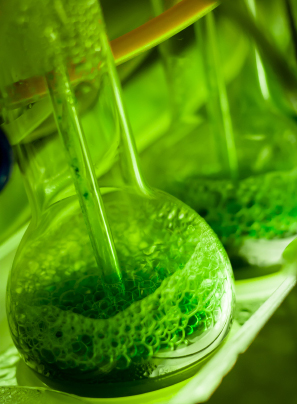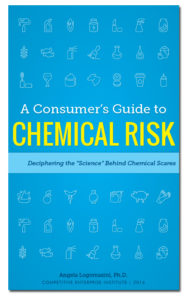 The phrase “green chemistry” on its own sounds cutting edge, scientific, progressive, and good for public health and the environment. The general idea is to remove “bad” or “dangerous” chemicals from the market and replace them with safer ones. But in reality, the term represents a political agenda to advance the wrongheaded notion that somehow regulators know better than private parties how to safely and efficiently meet consumer needs. Supposedly, not only will they protect us from alleged dangers, regulators will get involved in product design.
The phrase “green chemistry” on its own sounds cutting edge, scientific, progressive, and good for public health and the environment. The general idea is to remove “bad” or “dangerous” chemicals from the market and replace them with safer ones. But in reality, the term represents a political agenda to advance the wrongheaded notion that somehow regulators know better than private parties how to safely and efficiently meet consumer needs. Supposedly, not only will they protect us from alleged dangers, regulators will get involved in product design.
First, despite marketing of the term, this concept isn’t really new or cutting edge. Activists and leftist policy makers have tried to market this idea under various names ranging from the very boring “toxics use reduction” to the soft sounding “precautionary principle.”
The ostensive goals of “green chemistry” can be achieved without government, driven purely by market demand. In fact, industry performs its own version of green chemistry every time it develops new products because after all, they don’t succeed by poisoning their customers. They succeed by producing useful and safe products at affordable prices.
But the activists really want government-driven green chemistry, which is something completely different than market-driven green chemistry.
Here is how the U.S. Environmental Protection Agency (EPA) defines it:
Green chemistry is the design of chemical products and processes that reduce or eliminate the use or generation of hazardous substances.
Note the word “hazardous.” It focuses on replacing risk-management with risk elimination, which is impossible. Everything poses a “hazard” and under certain conditions could do harm, while under other conditions is perfectly safe. For example, we can die from consuming too much water, but the risk of that is low, particularly if we control our intake. Similarly, chemicals can be dangerous when exposure is high and long term, while low, short-term exposures may pose negligible risks. Regulators can use hazard as an excuse to regulate anything at any level. Accordingly regulations based on hazard grant bureaucrats arbitrary power rather than require them to adhere to scientific standards. Hence, we can eliminate answer B.
A definition found on an “educational” green chemistry website more clearly focuses on the green’s agenda:
Green Chemistry is a revolutionary philosophy that seeks to unite government, academic and industrial communities by placing more focus on environmental impacts at the earliest stage of innovation and invention.
Here Green chemistry is a philosophy (suggesting a way of life). It unites various players (involving more and more people), and it focuses on the “earliest stages” of product design. Product design and development become a political process. Some people even call it “collaborative chemistry.” Industry can’t accomplish this alone. It must be guided by bureaucrats and “stakeholders.”
Based on these definitions along with what I’m seeing in terms of green chemistry laws and advocacy at the state and federal levels, here’s my definition:
Green Chemistry is government-guided product design aimed at serving political preferences rather than market demands and economic, scientific, or engineering specifications.
This raises a very important question: Who really knows best when it comes to manufacturing and product design? Government or industry?
Green chemistry advocates appear to pick government despite some serious pitfalls associated with government policies that second-guess private-sector decisions. Bureaucrats lack situation-specific expertise as well as technical information that tens of thousands of product engineers working in thousands of businesses possess. It’s information that cannot be aggregated in government to design a product let alone guide an entire industry. Perhaps most disconcerting is that government regulators are not particularly accountable to consumers. When products fail or prices skyrocket, no one blames Uncle Sam or their state government bureaucracy. They blame business, which produces yet more regulation on business. Rather than mitigate green demands, which many businesses hope will happen if they play the green chemistry game, this process becomes a vicious cycle for industry.
And the result is very bad for consumers.
Consider the laws now on the books and under development in several state regulatory agencies. Washington, Minnesota, Maine, and California all have passed “green chemistry” laws that require bureaucrats to develop “chemicals of concern lists.” These are based on the “hazard profiles” of chemicals rather than real risks. And the criteria they use tends to select the most widely used and most widely tested chemicals.
Bad publicity from unfair listing of chemicals can force companies to reformulate their products, replacing well-studied chemicals with less understood and potentially more dangerous alternatives. Walmart, Target, and other stores have already pulled vinyl shower curtains and other innocuous products off the shelves because of hype generated by EPA “concern lists.”
Laws in California and Maine go even further, commencing regulations that will force companies to reformulate products that use politically unpopular chemicals.
The underlying assumption that regulations serve society by forcing industry to find alternatives to a a growing list of politically selected “problem” chemicals is foolish as it ignores long-term societal costs. What society can survive if it continues to throw away its useful technologies for no good reason? And when one product is banned, companies must divert resources away from other enterprises that might have benefited society in order to find substitute chemicals and reformulate products. The costs to our economic well-being and overall human progress are substantial.
Such forced reformulation also wrongly assumes that alternatives will be safer and work as well. But by definition, all existing alternatives are inferior, which is why they did not win the marketplace originally. Substitute products are usually less tested as well, raising the prospect that they are not any safer than the products banned by government.
Browse the terms on the sidebar of this webpage for more details and/or download a copy of A Consumer’s Guide to Chemical Risk: Deciphering the “Science” Behind Chemical Scares.


